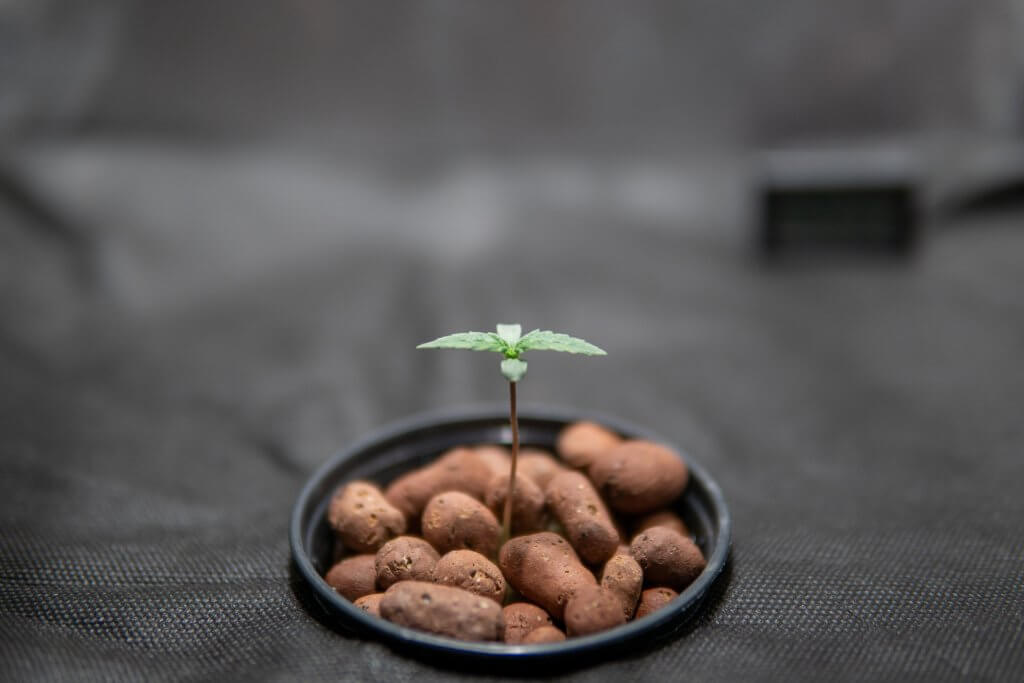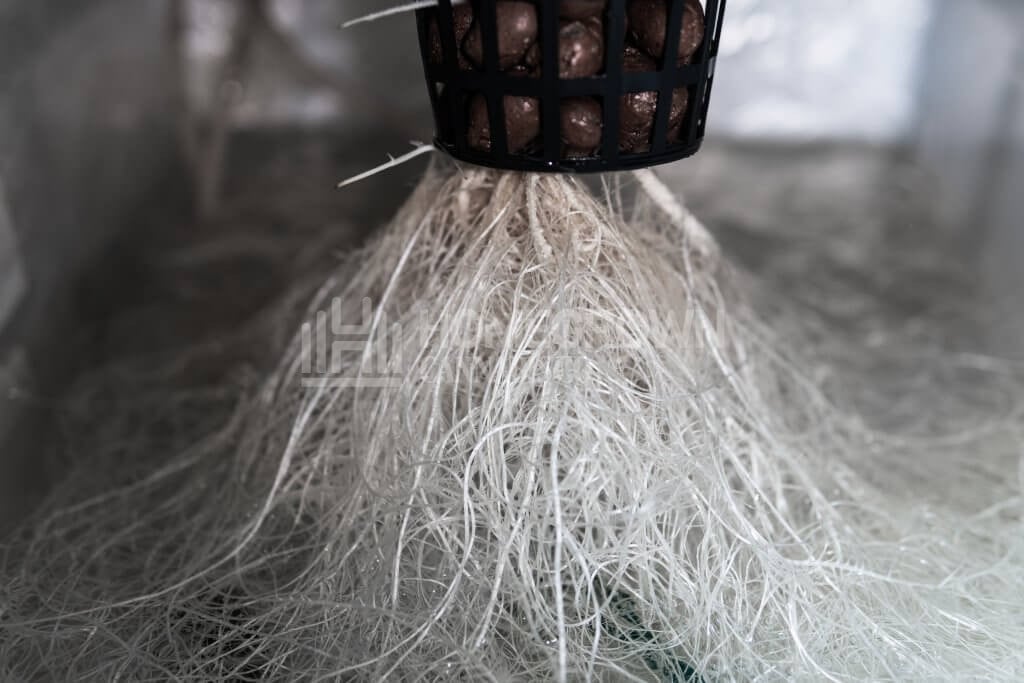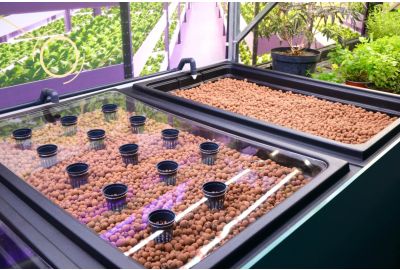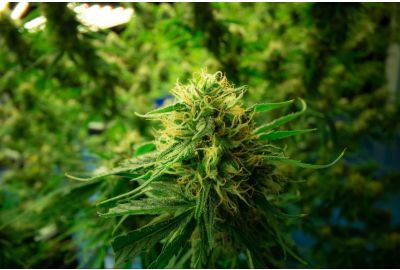Deep Water Culture Cannabis
It's high time you create a beautiful garden using the easy, widely used, and effective deep water culture cannabis hydroponic system. The concept is simple, and there are many ways to use and build such a structure with easily accessible materials.
We'll show you how to set up a DWC system (bubble bucket), the science behind it, and its practical applications. You'll see why deep water culture DIY isn’t just a way of avoiding purchasing expensive hydroponic systems but also a method of giving your plants exactly what they need. Let's roll.

What is the DWC grow system?
The main aim of hydro is to achieve fast growth rates in limited space and sterile conditions. Other common hydroponic weed setup systems are wick, drip, ebb and flow (flood and drain), NFT (nutrient film technique), and aeroponics.
DWC or bubble buckets is the simplest form of hydroponics because it doesn't require many components to build the structure or contain moving parts, making it great for beginners.
Plants in a deep water culture setup grow in an aerated, nutrient-rich, temperature-controlled, water-based solution. You can regulate all these variables, resulting in plants that are as healthy as is genetically possible.
A DWC grow system typically consists of a reservoir bucket to hold the nutrient solution, air pumps, and air stones. A single bubble bucket can support 1 to 4 plants, depending on the size and how large the plants grow.
Top-fed DWC system
This type of DWC system is best known as bubbleponics and is nearly identical to a typical deep water culture setup.
The top-fed version includes a water pump inside the reservoir that connects to small irrigation tubes. The little pipes get inserted into net pots that hang from the top of the bubbleponic setup.
The young roots emerge from this spot. It’s an excellent way to provide them with oxygen and nutrients before reaching the reservoir underneath. The result is fast-growing and well-established crops.
The advantages of choosing a bubbleponics DWC system are:
- Plants develop quickly within hours
- Roots can access the nutrient solution from the beginning
- Easy to maintain
- Doesn’t require a lot of space
- High-yielding plants, due to the easy nutrient access
As with any method, the top-fed system comes with potential drawbacks as the plants develop:
- The pump generates heat, which can increase the overall growing environment temperature. When the plants get too hot, they wilt, drastically reducing your final yield.
- Feeding from above may cause deposits to form around the upper root zone. This build-up stops oxygen from entering the roots and may cause your crop to die in extreme cases.
To avoid stressing your plants, discontinue the top-fed DWC system when they reach the aerated solution.
Bubbleponics vs. DWC: What are the main differences?
As bubbleponics is a DWC sub-technique, there are many similarities. Both methods use hydroponics to help your cannabis crops thrive and are excellent options for beginner growers. So, what sets them apart?
Let’s compare bubbleponics vs. DWC below to decipher how they vary.
How they administer nutrients
The primary difference between a regular DWC and the top-fed version is how they provide nutrients to your plants. Top-fed systems use feeding tubes with an air pump to nourish the roots.
A regular deep water culture setup uses an air pump but doesn’t require pipes. The crops’ roots absorb nutes from the surrounding H2O solution.
Some growers believe that top-fed is the most efficient hydro system due to the feeding tubes, but both work well to produce high-yielding crops.
Their appearance
The other way the two systems differ is in their appearance. A regular DWC involves suspending plants directly in a bucket with nutrients, air pumps, and air stones.
A top-fed DWC gets suspended above the water, so roots don’t touch the liquid initially. The feeding tubes provide nutrients into the net pots, and the roots hang and grow downward. Once they reach the aerated water solution, the pipes get disconnected.
How does deep water culture for cannabis work?
Some refer to a deep water culture system as a bubble bucket—it's exactly what it sounds like, a bucket with bubbling water. Air stones diffuse oxygen to the deep water culture nutrients solution inside the reservoir, so you can essentially be hands-off between nutrient changes.
A platform (net cups/pots) holds the plant and suspends the roots inside the reservoir. The cannabis roots grow and expand down, accessing minerals and oxygen that are pumped into the water.
The DWC setup is simple, and all you need are a few pieces of affordable equipment to put the structure together.
What are the advantages of growing weed in a DWC setup?
Starting your own deep water culture setup is easy once you get past the initial learning curve. Here are the top benefits of the system.
Less pest and disease issues
When it comes to DWC vs. soil, the former always beats the latter because common pests cannot find shelter in water. Seasoned cannabis cultivators know how annoying bugs are. You'll hardly ever use pesticides, thanks to DWC.
Faster veg times
Roots in a deep water culture setup become massive on top of being less prone to diseases. A combination of the fast growth rate and a controlled environment gives you predictable harvests consistently.

Lower water consumption
Hydroponics utilize significantly less water because it gets reused. Some statistics put it at an incredible 70–90% less water compared to conventional agricultural techniques.
Better nutrient control
With hydro, you're starting from zero and adding more. Control over deep water culture nutrients gives you the best, consistent, and most efficient product. You'll hardly face issues of nutrient lockout with DWC.
That’s not all; fertilizer doesn't run off from the soil to nearby water bodies, which is usually bad for the ecosystem.
Cheaper
Yes, cultivating in soil is straightforward, but think about the efficient and productive way of growing while using DWC for near-guaranteed results in the shortest times possible.
DWC's economical in the long run, more so when cultivating crops on a large scale. It’s an easy choice for most commercial cultivators pondering between DWC vs. soil because the water bill can be quite high if growing plants in earth.
More yields
Growing hydroponically sees crops develop quickly during the vegetative stage, in less space. This means you can enjoy faster harvests and grow again.
Cultivate passively
You can leave your plants unattended for a whole day when using a DWC grow system. Just make sure power's on to run the air pump and the water level doesn’t go down to anything unacceptable.
There’s no need to worry about watering your plants because their roots always have access to the nutrient solution in a DWC setup.
Are there any disadvantages to deep water culture for cannabis?
The biggest challenge when growing with DWC is the need for providing constant aeration to your water. Never let the air pump be off for a long time, or you could face root rot.
You have to be mindful of the system. If something breaks, then all your plants could suffer. A spoiled air pump causes the water to be depleted of oxygen, which can suffocate the roots in a DWC setup if this goes on for a long time.
Some users state that the weed isn’t as flavorful if the balance of deep water culture nutrients isn't correct. You can simply plant a seed in soil, water it as required, and you're good to go. However, when using a DWC setup, you must know how your plants grow and be familiar with variables such as pH, cannabis nutrients, and water temperature, which all affect your plants.
You should have the right nitrogen, phosphorus, and potassium ratios for cannabis plants in the vegetative and flowering stages. Ensure to get or make the ideal type of deep water culture nutrients solution suited to your plants because there's no buffering from the soil.

Step by step DWC grow guide: how to build your own DWC setup
Here's everything you'll need to hit the ground running with your deep water culture cannabis gardening plans. All the equipment discussed is available at most local hardware and online stores.
Deep water culture DIY materials
Here's what you'll need to make an easy, customizable deep water culture DIY system.
A nutrient reservoir
A reservoir can simply be a bucket that houses the nutrient-rich water, air stones on the bottom, and roots suspended in the solution. A huge advantage of a DWC setup is the ability to tune your system for maximum yield by letting plants share the same reservoir if the bucket size allows it.
You can get all kinds of sized buckets, ranging from 3 to around 20 gallons. The standard 5-gallon bucket should be more than enough for one deep water culture cannabis plant. Anything less won't provide adequate room for most cannabis plants' roots.
Choose a dark bucket because light hitting your solution provides the perfect environment for algae to grow, and that can affect the roots' health, consume nutrients, and be a hassle to clean.
Air pump
The air pump supplies oxygen to the water that’s taken in by the roots. The plant won't survive if the deep water culture nutrients solution isn't oxygenated. For this reason, the air pump should be running all the time and never off for an extended period. They’re cheap, and you can buy one in any aquarium store or online.
Get at least one air pump dedicated to each bucket. Some have up to eight outputs, but you never want to split that air between buckets. Why? Because the DWC water level for each one changes, resulting in different pressures. High water pressure in one bucket could significantly reduce the air supplied to another if shared.
Air stone
The air stone spreads the air into your deep water culture nutrients solution. There are all kinds of models in the form of discs and cylinders anywhere from 2 to 12 inches in diameter.
You can even have more than one air diffusing stone in your reservoir to increase the aeration rate. You don't need to spend too much money on this equipment because you'll usually discard them and get new ones after every run.
Air line
An air line is simply tubing that connects the air pump to the air stone inside your DWC setup. Ensure the tubing is bendable enough as it goes from the top of your bucket down into the air stone.
Growing medium
There are many cheap growing mediums such as Rockwool, coco coir, expanding clay, and more. The option you choose for your deep water culture cannabis setup is all down to preference, suitability, and accessibility.
Net pots
Net pots are simply cups with holes cut into them, creating a mesh that allows your plants' roots to spread out.
This item sometimes comes in the form of bucket lids designed to fit a five-gallon bucket. Ready-made net pots can be 6, 8, or 10 inches in diameter. Most deep water culture cannabis cultivators prefer to use the 6 to 8 inch sized net pot because they anchor the plant better as the roots grow.
Nutrients
The deep water culture nutrients solution must provide the right minerals and temperature to avoid harming your roots. Ensure the pH and ppm are suitable to the particular plant you're growing.
Remember to always add to the nutrient solution when the levels go down and clean out the whole unit if necessary.
Commercial cultivators like to make their own fertilizer, which can be a complicated process. Don't forget that we have the best nutrients for DWC setups if you’re cultivating cannabis at home.

Measuring kits
Get a pH meter and EC reader for efficiency. It’s advisable that you get two pH meters in case one becomes faulty.
Deep water culture guide step by step
Here's everything you'll need to do to set up the best DWC grow system.
Step 1: Cut the holes required
Drill a hole on the top edge of your reservoir or net pot for the air line to pass through. You can choose a smaller plastic bucket for your net pots. Make sure the holes are wide enough to allow roots to pass through but not too big to hold the DWC setup growing medium.
The custom net pots must be strong to support your plant, and its holes must be soft on the edges to avoid harming the roots.
Step 2: Add your aeration system
Position the air stone/s on the base of the bucket and connect them to the air infusion pump/s outside, using an airline. An air stone diffuses air better rather than just letting the pipe/airline work as it is. Turn on the pump, and you're good to go with your DWC grow system.
Step 3: Plant your seed
Drop your seed or seedling into the net pot that has the inert growing medium. The seed should be about an inch from the top surface. Don't forget to remove debris on your growing medium by using running water until it becomes clear.
The DWC water level should be close to the seedling in your growing medium. Lower it as time goes on to give the roots a reason to spread out. In the end, the DWC water level should be about an inch from the bottom surface of your net pot.
Step 4: Add your nutrient solution
Add the type and amount of nutrients to the water required by the plant you're growing. The best nutrients for DWC must have the right ppm (parts per million) or EC, pH, and temperature for guaranteed results. Your plants won't absorb nutrients well if these factors aren’t in check.
Deep water culture cannabis plants prefer a slightly acidic solution, with optimum pH varying between 5.5 to 6.5. Optimal EC ranges from 0.8–1.3 for cannabis seedlings, 0.5–1.3 for clones, 1.3–1.7 under the vegetative phase, and 1.2–2 during flowering. Some varieties of cannabis might require significantly different values of EC.
Following any creditable DWC nutrients guide, our pre-mixed solutions have different levels of NPK to suit every growth stage of your cannabis cultivars.
Roots prefer cool water to absorb maximum nutrients—this is one of the fundamental deep water culture tips many cultivators forget to adhere to. Optimum water temperatures range from 65 to 75℉.
A process cooling solution may be required in warm climates, so you can throw a bottle of frozen water into your bucket to keep the water cold enough if you face such an issue. Water that's around 65℉ holds oxygen better.
Step 5: Maintenance
Ensure the DWC water level stays where it's supposed to, adding to it when you see it drop. Remember, cannabis plants use so much water, and you wouldn't want the roots to dry out.
Keep an eye on the ppm and EC values to avoid changing your nutrient solution often. Track how many nutrients your plants use by noting the differences in ppm or EC.
Cannabis plants usually use more water than nutrients, so top off the balance with the pH-adjusted nutrient solution when the DWC water level goes down.
We recommend you clear the bucket once every two to three weeks if you don’t have the right measuring kits because there'll be excess nutrients in the solution that aren’t being used.
Your ppm can become too high if you add more nutrients to the solution, and your plant won't absorb what it needs due to nutrient lockout. Deep water culture cannabis plants enjoy 500–600 ppm after cloning, 800–900 ppm while vegetating, and 1000–1100 ppm when flowering.

FAQs
Here are answers to some of the most common questions we found regarding deep water culture for cannabis.
Do plants really grow faster in DWC?
Yes, plants grow faster in DWC vs. soil because they spend less energy searching for nutrients and pushing through the earth. Crops in a hydroponic system usually grow 40–50% faster compared to soil.
In deep water culture cannabis, the vegetative growth period is quite rapid, but flowering time is still the same as those cultivated in soil.
Does DWC increase yield?
Quicker veg times leads to increased yields because you can harvest more in the same growing season. However, the flowering stage isn't affected much, and this period is usually the same for whichever growing medium or setup you implement.
Some ganja farmers report up to a 20% increase in yield after switching from soil to deep water culture for cannabis.
Is DWC harder to do than soil?
The difficulty of DWC vs. soil is all a matter of perspective. Yes, the initial cost of setting up a DWC system is slightly higher, but it’s significantly cheaper when you look at all the advantages in the long run.
A deep water culture setup gives you a higher chance of getting the best product than soil, where plants are more susceptible to pests and diseases. Just make sure your nutrient solution is always aerated to prevent root rot and slime.
Should I try DWC for my first grow?
Why not? If you have all the equipment necessary and a reliable power source, then go for it. You'll enjoy faster veg periods and efficient use of water and nutrients. As a result, more people are adopting hydroponics for its numerous benefits.
We highly recommend the simple to make and cheap DWC hydroponics for beginners. As demonstrated in our build guide, you have many options for customizing the design so that you can create a garden catered to your space, crop selection, and budget.
Is DWC as stealthy as other grow styles?
How covert your DWC setup is largely depends on the sound of the air pump. Check how loud the pump is and if the noise is acceptable to you. Fortunately, modern air pumps are quite stealthy, and you can hang them in the air to reduce their racket.
Glue any vibrating parts stuck to curtail the buzz. You can build a noise reduction chamber around a large pump, just like you would for exhaust fans.
When it comes to DWC vs. soil, all you need to move about are bottles of your nutrient solutions rather than work with dirt and fertilizer that are more conspicuous.
Do you have to change the water in DWC?
You can usually avoid draining your reservoir for most of the DWC setup if you keep the pH and ppm/EC values in check.
However, beginners should switch the nutrient solution in the reservoir every 2 to 3 weeks because tracking optimal pH and nutrient level needs some experience and finesse.
Plants also need different levels of NPK during veg and flowering, so use a suitable nutrient solution for either stage.
Keeping dreams afloat with deep water culture DIY
We've discussed everything you'll need to get started with DWC and the technical aspects of cultivating using such a system. You can see that it doesn't take much to start.
Now go get everything you'll need to assemble your own, easily customizable, DIY DWC setup.
Buy our perfectly balanced nutrient solutions for a healthy and vibrant marijuana plant. Our fertilizer caters to the needs of your deep water culture cannabis garden from start to finish.
Top-fed DWC system
This type of DWC system is best known as bubbleponics and is nearly identical to a typical deep water culture setup.
The top-fed version includes a water pump inside the reservoir that connects to small irrigation tubes. The little pipes get inserted into net pots that hang from the top of the bubbleponic setup.
The young roots emerge from this spot. It’s an excellent way to provide them with oxygen and nutrients before reaching the reservoir underneath. The result is fast-growing and well-established crops.
The advantages of choosing a bubbleponics DWC system are:
- Plants develop quickly within hours
- Roots can access the nutrient solution from the beginning
- Easy to maintain
- Doesn’t require a lot of space
- High-yielding plants, due to the easy nutrient access
As with any method, the top-fed system comes with potential drawbacks as the plants develop:
- The pump generates heat, which can increase the overall growing environment temperature. When the plants get too hot, they wilt, drastically reducing your final yield.
- Feeding from above may cause deposits to form around the upper root zone. This build-up stops oxygen from entering the roots and may cause your crop to die in extreme cases.
To avoid stressing your plants, discontinue the top-fed DWC system when they reach the aerated solution.
Bubbleponics vs. DWC: What are the main differences?
As bubbleponics is a DWC sub-technique, there are many similarities. Both methods use hydroponics to help your cannabis crops thrive and are excellent options for beginner growers. So, what sets them apart?
Let’s compare bubbleponics vs. DWC below to decipher how they vary.
How they administer nutrients
The primary difference between a regular DWC and the top-fed version is how they provide nutrients to your plants. Top-fed systems use feeding tubes with an air pump to nourish the roots.
A regular deep water culture setup uses an air pump but doesn’t require pipes. The crops’ roots absorb nutes from the surrounding H2O solution.
Some growers believe that top-fed is the most efficient hydro system due to the feeding tubes, but both work well to produce high-yielding crops.
Their appearance
The other way the two systems differ is in their appearance. A regular DWC involves suspending plants directly in a bucket with nutrients, air pumps, and air stones.
A top-fed DWC gets suspended above the water, so roots don’t touch the liquid initially. The feeding tubes provide nutrients into the net pots, and the roots hang and grow downward. Once they reach the aerated water solution, the pipes get disconnected.
About the author: Parker Curtis
Parker Curtis has around a decade of cannabis-growing experience, specialising in soil-less and hydro grows. He’s mastering outdoor, greenhouse, and indoor grows.

